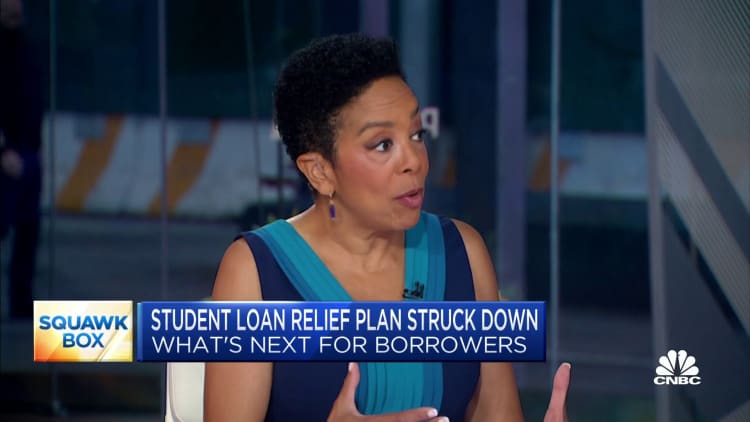
After the Supreme Court struck down the Biden administration’s plan to wipe away about $430 billion dollars in student loan debt, many borrowers are now scrambling to figure out exactly when their next payment is due, how much they owe and whether they’ll be able to afford that bill.
President Joe Biden has promised to continue to work on a proposal to forgive student loan debt. Yet, “under the law, this path could take time,” admitted U.S. Education Secretary Miguel Cardona, vowing to keep borrowers updated in the months ahead.
For now, the Biden administration is taking action to help provide some relief to borrowers by offering a more affordable income-driven repayment plan.
More from Your Money:
The new Saving on a Valuable Education, or SAVE Plan, will cut down the amount borrowers have to make on monthly payments by half — to just 5% of their disposable income, down from 10%. This new SAVE plan will replace the existing Revised Pay As You Earn, or REPAYE, plan and “will go into effect this summer,” according to the U.S. Department of Education’s website.
The department will also give borrowers a bit of a break if they can’t make loan payments in the first year by not referring missed payments to credit reporting agencies for 12 months.
Here’s what borrowers can do right now
Oscar Wong | Moment | Getty Images
Still, after a three-year pause, tens of millions of federal student loan borrowers will have to start making payments again this fall. Interest will start to accrue on Sept. 1, and payments will be due in October. To prepare, borrowers should take these five steps now:
- Make sure your contact information is current. Go to studentaid.gov — part of the Education Department’s website — to update your contact information. You want to make sure you don’t miss billing statements and due dates.
- Connect with your loan servicer. You want to make sure your loan servicer also has your most up-to-date contact information. Your loan servicer may have changed over the past three years or you may have moved. To find out who your loan servicer is, visit your account dashboard at studentaid.gov and scroll down to the “My Loan Servicers” section.
- Apply for an income-driven repayment plan. Many borrowers are already struggling financially. The Consumer Financial Protection Bureau estimates 1 in 5 borrowers are at financial risk of being unable to resume repayments. If you are trying to figure out how to afford those bills in October, apply for an income-driven repayment plan. You can find out more about IDR plans, including the new “SAVE” plan, here.
- Estimate your monthly payment and sign up for auto-debit. You can compare repayment plans and get an idea of what your monthly payment will be by going to the “Loan Simulator” tool here. This is also a good time to review whether you have signed up to auto-debit enrollment to ensure your payments are made on time. Contact your loan servicer directly to sign up to automatically deduct your monthly payment from your bank account. Even if you had auto-debit before the pause, confirm that you are enrolled once again with your payment plan.
- Open a high-yield savings account. Start making loan payments to yourself now by stashing money in a high-yield savings account. You can go here to find financial institutions offering the most competitive savings rates. Putting money in a saving account, earmarked for student debt payments, can be good practice to see how you’ll handle paying those bills when they’re due again in October.
Học bổng là một phương pháp tối ưu để giúp người dân Việt Nam thực hiện cải cách và nâng cao trình độ học vấn chuyên môn. Tuy nhiên, khi lãi học bổng thường được bỏ qua, các học sinh thường bị đe doạ một cách thức khó khăn khi phải thanh toán. Với quyết định mới của Tòa án Tối cao Việt nam về việc bãi bỏ quy tắc hủy bỏ nợ học bổng, Việt Nam đang bước đến một không gian để học bổng là một phương tiện hỗ trợ để vươn tới mục tiêu và ước mơ của riêng mình.
Do đó, để tận dụng cơ hội này, cũng như tránh bị cản trở khi thanh toán nợ học bổng, người vay học bổng nên thực hiện ngay bây giờ những bước sau đây:
– Đầu tiên, làm rõ nợ học bổng của bạn. Từ đó, bạn có thể đưa ra các giải pháp hợp lý về việc thanh toán như vắng mặt hay gia hạn thanh toán.
– Tiếp theo, liên hệ với trường học hoặc tổ chức hỗ trợ bạn đã tham gia vay học bổng, sau đó họ sẽ giúp bạn xác định loại học bổng, lãi suất và các điều khoản còn lại của nợ học bổng.
– Ngoài ra, bạn cũng nên liên hệ với các tổ chức, chi nhánh hàng đầu để có được thông tin về các chương trình ưu đãi sẽ giúp bạn được miễn nợ học bổng, hay hỗ trợ giảm các khoản chi phí để thanh toán nợ.
Bằng cách thực hiện các bước nêu trên, người vay học bổng có thể giảm thiểu mức độ đe doạ khi phải thanh toán nợ học bổng. Bạn cũng có thể nâng cao quyền lợi của bản thân và cả những người hỗ trợ bạn trong việc đạt được thành công trên con đường học vấn.
